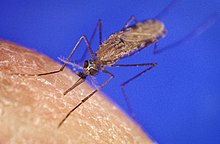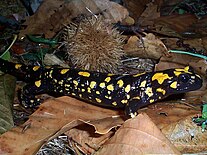Species complex

In biology, a species complex is a group of closely related
Two or more taxa that were once considered
Species complexes exist in all groups of organisms and are identified by the rigorous study of differences between individual species that uses minute morphological details, tests of
Definition
A species complex is typically considered as a group of close, but distinct species.
A more restricted use applies the term to a group of species among which
Some authors apply the term to a species with intraspecific variability, which might be a sign of ongoing or incipient speciation. Examples are ring species[10][11] or species with subspecies, in which it is often unclear if they should be considered separate species.[12]
Related concepts

Several terms are used synonymously for a species complex, but some of them may also have slightly different or narrower meanings. In the
- Cryptic species
- Cryptic species are morphologically identical species. More generally, the term is often applied when species, even if they are known to be distinct, cannot be reliably distinguished by morphology.[16] .
- Sibling species
- Also called aphanic species. This term, introduced by sister species", "two species that are the closest relative of each other and have not been distinguished from one another taxonomically".[19]
- Species flock
- Also called species swarm. This refers to "a monophyletic group of closely related species all living in the same ecosystem".[19] Conversely, the term has also been applied very broadly to a group of closely related species than can be variable and widespread.[20] Not to be confused with a mixed-species foraging flock, a behavior in which birds of different species feed together.
- Superspecies
- Sometimes used as an informal rank for a species complex around one "representative" species.
- Species aggregate
- Used for a species complex, especially in plant taxa where polyploidy and apomixis are common. Historical synonyms are species collectiva, introduced by Adolf Engler, conspecies, and grex.[24] Components of a species aggregate have been called segregates or microspecies.[24] Used as abbreviation agg. after the binomial species name.[8][25]
- Sensu lato
- A Latin phrase meaning 'in the broad sense', it is often used after a binomial species name, often abbreviated as s.l., to indicate a species complex represented by that species.[26][27][28]
Identification
Distinguishing close species within a complex requires the study of often very small differences. Morphological differences may be minute and visible only by the use of adapted methods, such as
Analysis of
Evolution and ecology
Speciation process
Species forming a complex have typically diverged very recently from each other, which sometimes allows the retracing of the process of speciation. Species with differentiated populations, such as ring species, are sometimes seen as an example of early, ongoing speciation: a species complex in formation. Nevertheless, similar but distinct species have sometimes been isolated for a long time without evolving differences, a phenomenon known as "morphological stasis".[19] For example, the Amazonian frog Pristimantis ockendeni is actually at least three different species that diverged over 5 million years ago.[33]
Stabilizing selection has been invoked as a force maintaining similarity in species complexes, especially when they adapted to special environments (such as a host in the case of symbionts or extreme environments).[19] This may constrain possible directions of evolution; in such cases, strongly divergent selection is not to be expected.[19] Also, asexual reproduction, such as through apomixis in plants, may separate lineages without producing a great degree of morphological differentiation.

a – morphological stasis
b – hybrid speciation
A species complex is usually a group that has one common ancestor (a
Range and habitats
Sources differ on whether or not members of a species group share a
Often, such complexes do not become evident until a new species is introduced into the system, which breaks down existing species barriers. An example is the introduction of the Spanish slug in Northern Europe, where interbreeding with the local black slug and red slug, which were traditionally considered clearly separate species that did not interbreed, shows that they may be actually just subspecies of the same species.[37]
Where closely related species co-exist in
A species flock may arise when a species penetrates a new geographical area and diversifies to occupy a variety of ecological niches, a process known as adaptive radiation. The first species flock to be recognized as such was the 13 species of Darwin's finches on the Galápagos Islands described by Charles Darwin.
Practical implications
Biodiversity estimates
It has been suggested that cryptic species complexes are very common in the marine environment.[38] That suggestion came before the detailed analysis of many systems using DNA sequence data but has been proven to be correct.[39] The increased use of DNA sequence in the investigation of organismal diversity (also called phylogeography and DNA barcoding) has led to the discovery of a great many cryptic species complexes in all habitats. In the marine bryozoan Celleporella hyalina,[40] detailed morphological analyses and mating compatibility tests between the isolates identified by DNA sequence analysis were used to confirm that these groups consisted of more than 10 ecologically distinct species, which had been diverging for many millions of years.
Evidence from the identification of cryptic species has led some[who?] to conclude that current estimates of global species richness are too low.
Disease and pathogen control

Pests, species that cause diseases and their vectors, have direct importance for humans. When they are found to be cryptic species complexes, the ecology and the virulence of each of these species need to be re-evaluated to devise appropriate control strategies.[citation needed] Examples are cryptic species in the malaria vector genus of mosquito, Anopheles, the fungi causing cryptococcosis, and sister species of Bactrocera tryoni, or the Queensland fruit fly. That pest is indistinguishable from two sister species except that B. tryoni inflicts widespread, devastating damage to Australian fruit crops, but the sister species do not.[42]
Conservation biology
When a species is found to be several phylogenetically distinct species, each typically has smaller distribution ranges and population sizes than had been reckoned. The different species can also differ in their ecology, such as by having different breeding strategies or habitat requirements, which must be taken into account for appropriate management.[citation needed] For example, giraffe populations and subspecies differ genetically to such an extent that they may be considered species. Although the giraffe, as a whole, is not considered to be threatened, if each cryptic species is considered separately, there is a much higher level of threat.[43]
See also
References
- PMID 24478591.
- ^ S2CID 619242.
- ^ S2CID 38285623.
- ^ Moran P, Kornfield I (1993). "Retention of an Ancestral Polymorphism in the Mbuna Species Flock (Teleostei: Cichlidae) of Lake Malawi" (PDF). Molecular Biology and Evolution. 10 (5): 1015–1029.
- .
- PMID 18027281.
- ^ ISBN 978-0-674-69013-4.
- ^ PMID 20401184.
- ^ JONG, R. (December 1987). "Superspecies Pyrgus malvae (Lepidoptera: Hesperiidae) in the East Mediterranean, with notes on phylogenetic and biological relationships". Rijksmuseum van Natuurlijke Historie – Via Naturalis Repository.
- S2CID 49267121.
- S2CID 221735739.
- S2CID 16832446.
- ISBN 978-0853010067.
- PMID 21089234.
- ^ McNeill, J; et al., eds. (2012), International Code of Nomenclature for algae, fungi, and plants (Melbourne Code), adopted by the Eighteenth International Botanical Congress Melbourne, Australia, July 2011 (electronic ed.), Bratislava: International Association for Plant Taxonomy, retrieved 2012-12-20.
- ISSN 1996-7489.
- ISBN 9780674862500.
- doi:10.1093/sysbio/21.4.446. Archived from the original(PDF) on 2015-02-07.
- ^ PMID 17129636.[permanent dead link]
- PMID 8197196.
- .
- PMID 28568488.
- ^ .
- ^ a b Heywood VH. (1962). "The "species aggregate" in theory and practice". In VH Heywood; Löve Á. (eds.). Symposium on Biosystematics, organized by the International Organization of Biosystematists, Montreal, October 1962. pp. 26–36.
- S2CID 26360705.
- S2CID 85946696.
- ^ .
- S2CID 25615396.
- PMID 26612464.
- ISSN 0024-4082.
- ^ S2CID 10952136.
- ^ PMID 18154647.
- PMID 17319954.

- ^ "Iowa State University Department of Agronomy". Archived from the original on 2011-10-05. Retrieved 2015-01-01.
- ^ "Species Group | Encyclopedia.com". www.encyclopedia.com. Retrieved 18 October 2019.
- ^ (in Danish) Engelke, S. (2006?): Til Snegleforeningen (Note to the Danish Slug-society). Article in Danish [dead link]
- ISSN 0066-4162.
- S2CID 40909997.
- PMID 17035167.
- PMID 8041714.
- ISSN 0003-4746.
- PMID 18154651.





